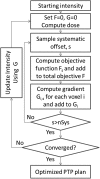Comparisons of treatment optimization directly incorporating systematic patient setup uncertainty with a margin-based approach
- PMID: 22320820
- PMCID: PMC3293365
- DOI: 10.1118/1.3679856
Comparisons of treatment optimization directly incorporating systematic patient setup uncertainty with a margin-based approach
Abstract
Purpose: To develop a probabilistic treatment planning (PTP) method which is robust to systematic patient setup errors and to compare PTP plans with plans generated using a planning target volume (PTV) margin optimized to give the same target coverage probability as the PTP plan.
Methods: Plans adhering to the RTOG-0126 protocol are developed for 28 prostate patients using PTP and margin-based planning. For PTP, an objective function that simultaneously considers multiple possible patient positions is developed. PTP plans are optimized using clinical target volume (CTV) structures and organ at risk (OAR) structures. The desired CTV coverage probability is 95%. Plans that cannot achieve a 95% CTV coverage probability are re-optimized with a desired CTV coverage probability reduced by 5% until the desired CTV coverage probability is achieved. Margin-based plans are created which achieve the same CTV coverage probability as the PTP plans by iterative adjustment of the CTV-to-PTV margin. Postoptimization, probabilistic dose-volume coverage metrics are used to compare the plans.
Results: For equivalent target coverage probability, PTP plans significantly reduce coverage probability for rectum objectives (-17% for D(35) < 65 Gy, p = 0.0010; -23% for D(25) < 70 Gy, p < 0.0001; and -27% for D(15) < 75 Gy, p < 0.0001). Physician assessment indicates PTP plans are entirely preferred 71% of the time while margin-based plans are entirely preferred 7% of the time.
Conclusions: For plans having the same target coverage probability, PTP has potential to reduce rectal doses while maintaining CTV coverage probability. In blind comparisons, physicians prefer PTP plans over optimized margin plans.
Figures






Similar articles
-
Comparisons of treatment optimization directly incorporating random patient setup uncertainty with a margin-based approach.Med Phys. 2009 Sep;36(9):3880-90. doi: 10.1118/1.3176940. Med Phys. 2009. PMID: 19810460 Free PMC article.
-
Coverage optimized planning: probabilistic treatment planning based on dose coverage histogram criteria.Med Phys. 2010 Feb;37(2):550-63. doi: 10.1118/1.3273063. Med Phys. 2010. PMID: 20229863 Free PMC article.
-
Evaluation of dosimetric margins in prostate IMRT treatment plans.Med Phys. 2008 Feb;35(2):569-75. doi: 10.1118/1.2826558. Med Phys. 2008. PMID: 18383678 Free PMC article.
-
PTV-based IMPT optimization incorporating planning risk volumes vs robust optimization.Med Phys. 2013 Feb;40(2):021709. doi: 10.1118/1.4774363. Med Phys. 2013. PMID: 23387732 Free PMC article.
-
Robust optimization in lung treatment plans accounting for geometric uncertainty.J Appl Clin Med Phys. 2018 May;19(3):19-26. doi: 10.1002/acm2.12291. Epub 2018 Mar 10. J Appl Clin Med Phys. 2018. PMID: 29524301 Free PMC article. Review.
Cited by
-
Coping with interfraction time trends in tumor setup.Med Phys. 2020 Feb;47(2):331-341. doi: 10.1002/mp.13919. Epub 2019 Dec 10. Med Phys. 2020. PMID: 31721232 Free PMC article.
-
Multiple anatomy optimization of accumulated dose.Med Phys. 2014 Nov;41(11):111705. doi: 10.1118/1.4896104. Med Phys. 2014. PMID: 25370619 Free PMC article.
-
Dose deformation-invariance in adaptive prostate radiation therapy: implication for treatment simulations.Radiother Oncol. 2012 Nov;105(2):207-13. doi: 10.1016/j.radonc.2012.10.011. Epub 2012 Nov 29. Radiother Oncol. 2012. PMID: 23200409 Free PMC article.
-
Evaluating deviations in prostatectomy patients treated with IMRT.Rep Pract Oncol Radiother. 2016 May-Jun;21(3):266-70. doi: 10.1016/j.rpor.2015.11.004. Epub 2015 Dec 29. Rep Pract Oncol Radiother. 2016. PMID: 27601960 Free PMC article.
-
Target margins in radiotherapy of prostate cancer.Br J Radiol. 2016 Nov;89(1067):20160312. doi: 10.1259/bjr.20160312. Epub 2016 Jul 20. Br J Radiol. 2016. PMID: 27377353 Free PMC article. Review.
References
-
- International Commission on Radiation Units and Measurements., Prescribing, Recording, and Reporting Photon Beam Therapy (International Commission on Radiation Units and Measurements, Bethesda, Md., 1999).
-
- International Commission on Radiation Units and Measurements., Prescribing, Recording, and Reporting Photon Beam Therapy (International Commission on Radiation Units and Measurements, Bethesda, MD, 1993).
Publication types
MeSH terms
Grants and funding
LinkOut - more resources
Full Text Sources
Medical

